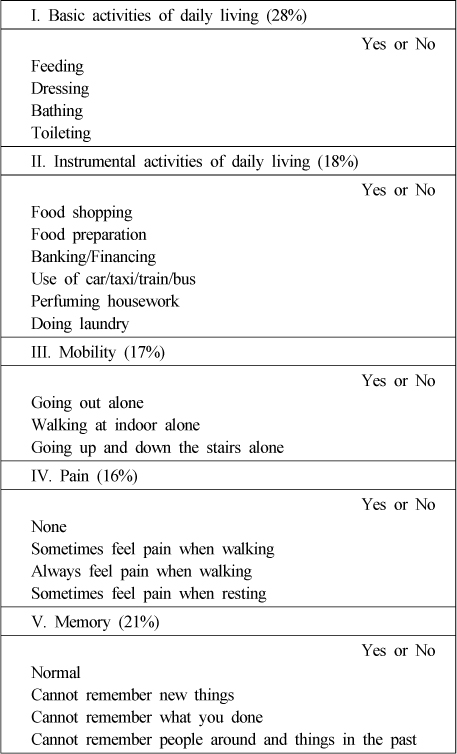Articles
- Page Path
- HOME > J Musculoskelet Trauma > Volume 25(1); 2012 > Article
-
Original Article
- The Daily Life Functions of Elderly Peritrochanteric Fracture Patients after Surgical Treatment
- Dae Moo Shim, M.D., Ph.D., Tae Kyun Kim, M.D., Ph.D., Jong Yun Kim, M.D., Ph.D., Duk Hwa Choi, M.D., Ph.D., Joung Suk Lee, Ph.D., Seong In Lee, M.D.
-
Journal of the Korean Fracture Society 2012;25(1):8-12.
DOI: https://doi.org/10.12671/jkfs.2012.25.1.8
Published online: January 31, 2012
Department of Orthopaedic Sugery, Wonkwang University College of Medicine, Iksan, Korea.
*Department of Anesthesiology, Gunsan Medical Center of Wonkwang University Hospital, Gunsan, Korea.
†Department of Nursing Survice, Gunsan Medical Center of Wonkwang University Hospital, Gunsan, Korea.
- Address reprint requests to: Tae Kyun Kim, M.D., Ph.D. Department of Orthopaedic Surgery, School of Medicine, Wonkwang University Hospital, 344-2, Shinyong-dong, Iksan 570-711, Korea. Tel: 82-63-859-1363, Fax: 82-63-852-9329, osktg@wonkwang.ac.kr
• Received: June 10, 2011 • Revised: September 26, 2011 • Accepted: October 20, 2011
Copyright © 2012 The Korean Fracture Society
- 381 Views
- 2 Download
Abstract
-
Purpose
- Although most peritrochanteric fractures in old age necessitates surgical treatment, daily life functions are still impaired after discharge. We assessed the types of peritrochanteric fracture, risk factors, and functional recovery in elderly patients who were over 65 years old. We also tried to determine factors for recovery to daily life.
-
Materials and Methods
- From January 2006 to December 2007, among 61 patients who were over 65 years old with the possibility of 1 year follow-up, 50 patients were selected through interviews. After verifying age, sex, mode, types of fracture, and method, we analyzed daily living activities with a functional recovery index and estimated recovery of daily life functions after surgery, assuming a score increase if functional recovery was good.
-
Results
- The mean age was 75.8 years, and females (31 patients, 62%) exceeded males. Slipping (27 patients, 54%) was the most common cause of fracture, and the intertrochanteric femur fracture was the most common fracture type (34, 68%). The average functional recovery index decreased 16.24% compared with the pre-operation value, having a tendency to decrease more in old age and female patients. Subtrochanteric femur fracture showed a 17.6% decrease in functional recovery index among the fracture types.
-
Conclusion
- In elderly patients over 65 years, the functional recovery index after peritrochanteric fracture decreased 16.24% on average compared with the preoperation state. The largest decrease was in basic life ability. The functional recovery index decreased more in old age, females, and subtrochanteric femur fracture, which indicates these factors influence functional recovery.
- 1. Bonar SK, Tinetti ME, Speechley M, Cooney LM. Factors associated with short- versus long-term skilled nursing facility placement among community-living hip fracture patients. J Am Geriatr Soc, 1990;38:1139-1144.
- 2. Chung HK, Choi CH, Choi YJ, Lee JH. The patient's satisfactory degree for total knee arthroplasty in Korean. J Korean Orthop Assoc, 1997;32:1275-1282.ArticlePDF
- 3. Clemson L, Cumming RG, Roland M. Case-control study of hazards in the home and risk of falls and hip fractures. Age Ageing, 1996;25:97-101.Article
- 4. Cooper C, Campion G, Melton LJ 3rd. Hip fractures in the elderly: a world-wide projection. Osteoporos Int, 1992;2:285-289.ArticlePDF
- 5. Cummings SR, Kelsey JL, Nevitt MC, O'Dowd KJ. Epidemiology of osteoporosis and osteoporotic fractures. Epidemiol Rev, 1985;7:178-208.
- 6. Gross M. A critique of the methodologies used in clinical studies of hip-joint arthroplasty published in the English-language orthopaedic literature. J Bone Joint Surg Am, 1988;70:1364-1371.Article
- 7. Kho DH, Kim KH, Shin JY, Lee JH, Kim DH. Postoperative mortality rate of hip fracture in elderly patients. J Korean Fract Soc, 2006;19:117-121.Article
- 8. Kim JO, Yoen YH, Ko YD, et al. The prefracture factors on the hip fracture in elderly. J Korean Soc Fract, 2002;15:531-537.Article
- 9. Park OJ. Gerontologocal nursing, 1999;Ki-huyn publisher. 7-25.
- 10. Rosser RM, Watts VC. The measurement of hospital output. Int J Epidemiol, 1972;1:361-368.
- 11. Schroeder SA. Outcome assessment 70 years later: are we ready? N Engl J Med, 1987;316:160-162.Article
- 12. Svensson O, Strömberg L, Ohlén G, Lindgren U. Prediction of the outcome after hip fracture in elderly patients. J Bone Joint Surg Br, 1996;78:115-118.ArticlePDF
- 13. Wright JG, Rudicel S, Feinstein AR. Ask patients what they want. Evaluation of individual complaints before total hip replacement. J Bone Joint Surg Br, 1994;76:229-234.ArticlePDF
- 14. Yu CH, Lee YS, Lee JS. Some factors affecting bone density of Korean college Women. Korean J Nutr, 1998;31:36-45.
- 15. Zuckerman JD, Koval KJ, Aharonoff GB, Hiebert R, Skovron ML. A functional recovery score for elderly hip fracture patients: I. Development. J Orthop Trauma, 2000;14:20-25.Article
REFERENCES
Figure & Data
REFERENCES
Citations
Citations to this article as recorded by 

The Daily Life Functions of Elderly Peritrochanteric Fracture Patients after Surgical Treatment


Fig. 1
Fuctional recovery index checklist.
Fig. 2
78 years old female was taken internal fixation using gamma nailing.
(A) Preoperation radiograph.
(B) At 36 month after nailing, bone union was not made completely.
(C) Bone densitomet shows osteoporosis (T-score: -4.8).
Fig. 1
Fig. 2
The Daily Life Functions of Elderly Peritrochanteric Fracture Patients after Surgical Treatment
Around hip joint fracture functional recovery index
p>0.05.
Gender functional recovery index
p>0.05.
Table 1
Around hip joint fracture functional recovery index
p>0.05.
Table 2
Gender functional recovery index
p>0.05.

 E-submission
E-submission KOTA
KOTA TOTA
TOTA TOTS
TOTS




 Cite
Cite

